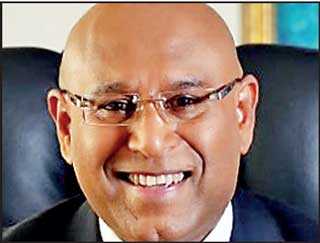Saturday Dec 06, 2025
Saturday Dec 06, 2025
Friday, 14 August 2020 00:05 - - {{hitsCtrl.values.hits}}
The National Development Bank PLC, said yesterday it had recorded sound results for the first six months ended 30 June 2020, demonstrating its stability and resilience at the face of the economic and business disruptions resulted from the COVID-19 pandemic.
 |
| Chairman Eshana De Silva |
 |
| Director/Group CEO Dimantha Seneviratne
|
The bank also actively strategised and extended much-needed support to customers affected by the pandemic and initiated many plans, which would ensure wider benefits to the economy at large, in its role as a responsible financier in the country.
NDB Director/Group Chief Executive Officer Dimantha Seneviratne said: “NDB’s strategic focus, experience and competence in weathering economic cycles, its talented pool of human capital with a customer-centric approach and efficient processes have enabled the bank to perform well amidst challenging conditions.”
The GCEO emphasised that the bank was harnessing the best of these strengths and was s fully committed towards propelling the bank’s customers and the country’s growth towards financial prosperity.
The period under review was marked by the heightened impact of the pandemic with a complete lockdown for over two months in which economic activity was at near zero. During the lockdown, NDB carried out banking services to the maximum extent possible, via multiple modes of digital channels, branches functioning at selected localities and three mobile ATMs for the benefit of its customers.
With the country gradually opening up, the bank has allocated extra resources to ensure maximum support to and financial well-being of the affected customers and to assist them emerge from the downturn expeditiously.
The bank said it was efficiently passing on the benefits of monetary policy easing measures introduced by the Central Bank of Sri Lanka by reducing overall lending rates of the bank and lending to productive sectors of the economy, which would reinforce support to COVID-19 hit businesses as well as to the broader economy.
NDB granted moratoriums spanning up to six months introduced by the CBSL to c. 40% of its Loan Book, amounting to over Rs. 170 b, including personal and business customers. Of the loans approved to support pandemic-affected customers, as of end July 2020, over Rs. 7 b was from the CBSL’s Saubhagya COVID-19 Renaissance refinancing scheme priced at a concessionary lending rate of 4%, of which over Rs. 4.5 b has already been disbursed.
In addition to the financial support, the bank also provides advisory support to the affected businesses and carry out close monitoring to ensure that they are ready to operate with stability once the moratoriums and concessions unwind. The bank said it was also conscious that certain customers may require extended moratorium periods, restructuring of facilities and other customised support, based on the industries that they represent and distinct challenges they face.
NDB’s Jayagamu Sri Lanka program is actively channelling added support to segments such as SMEs and inventors via both financial support which includes loans at reduced interest rates and waivers on fees, advisory support and several tie-ups with trade and export platforms, ERP solutions, etc., with the aim to propel national economic revival.
Revenue was under pressure during the H1 2020, stemming from stressed macro-economic conditions. With the reduction of policy rates and less demand for credit, the net interest margin came down to 3.25% from 3.53% in end 2019. With the combined effect of reduced NIM and lower business volumes, net interest income was Rs. 8.8 b, a marginal growth of 2% over the prior period.
Fee and commission income was Rs. 1.7 b, a reduction of 1% over the comparative period in 2019, again a direct reflection of reduced business volumes and also due to waivers granted on certain fees as a relief measure. Net gains from trading of Rs. 537 m was also a reduction of 21%.
The bank realised capital gains from the Government securities portfolio, as reflected under net gains from de-recognition of financial assets. Resultant total operating income was Rs. 13 b, up by 11% over H1 2019.
Impairment charges for loans and other losses for H1 2020 was Rs. 3.2 Bn and was a 69% increase over H12019. The increase in the impairment charges was mainly due to the increase in the collective provision charge in line with the growth in the loan book and provisions made at individual levels in response to elevated risks caused by the pandemic and other stresses.
The bank also accounted for the day one impact on the moratoriums where significant interest concessions were given amounting to Rs. 626 n, under other impairment charges, as prescribed by SLFRS 09: Financial Instruments. The bank’s regulatory Non-Performing Loan (NPL) ratio was 5.40% and was at par with the industry for the period under review.
Total operating expenses for H1 2020 was Rs. 4.7 b, a slight YoY reduction from H1 2019. The bank implemented a large number of cost management initiatives in response to the pandemic, and same coupled with the bank’s technology driven process efficiencies already in place contributed towards achieving this reduction in expenses. Accordingly, the cost to income ratio for H1 2020 was 36.2%, an improvement from 39.9% in 2019.
The total tax charge for H1 2020 was Rs. 2.1 b, comprising Rs. 965 m in VAT on financial services and Rs. 1.1 b in Income Tax. The effective tax rate for H1 2020 was 41%, down from 56% in H1 2019 due to the removal of Nation Building Tax (NBT) and Debt Repayment Levy (DRL), w.e.f. 01 January 2020. The resultant post-tax profit at the bank level was Rs. 3 b and profit attributable to shareholders at the Group level was Rs. 2.4 b, a YoY increase of 34% and 32% respectively.
Total assets stood at Rs. 562 b at the bank level and Rs. 567 b at the Group level, a healthy growth of 6% over 2019 (YTD) and 15% year-on-year (YoY). The gross loan book stood at Rs. 429 b, a YTD growth of 5%, whist same on a YoY basis was 15%. The YoY growth is a quantum increase of Rs. 56 b.
Customer deposits was Rs. 428 b and recorded an YTD growth of 6% and YoY growth of 21%. The YoY growth translates to a quantum of Rs. 73 b. Accordingly, the bank’s loans to deposits ratio improved to 100%. Within deposits, the CASA base recorded a 9% growth, enhancing the CASA ratio to 21% from 20% in 2019. Furthermore, during June 2020, the bank redeemed debentures worth of Rs. 10 b issued in 2015 with a tenor of five years.
The bank’s Tier I and total capital ratios as at 30 June 2020 were 9.30% and 12.94% whilst the same at the Group level were 10.09% and 13.57% [minimum requirements of 8.0% and 12.0% respectively]. The bank has announced a debenture issue in July 2020 to issue 50,000,000 Basel III compliant – Tier II, listed, rated, unsecured, subordinated redeemable five year debentures of Rs. 100 each, with a non-viability conversion feature amounting to Rs. 5 b, with an option to issue up to a further 15,000,000 of said debentures to raise up to Rs. 1.5 b in the event of an oversubscription of the initial issue. Funds raised via this issue will further strengthen the Tier II capital base of the bank and support envisaged business growth.
The bank’s Liquidity Coverage Ratios were 136% and 121% for Rupee and All Currency respectively as of 30 June 2020 and were above the statutory minimum requirement of 90%. The Net Stable Funding Ratio was 107%, and compared with the statutory minimum requirement of 90%.
The Return on Average Shareholder Funds (ROE) for the bank was of 12.18% [2019:13.73%] and the Earnings per Share Rs. 21.56 [2019: Rs. 23.05] for H1 2020. The same ratios for the Group were 9.49% [2019: 11.59%] and Rs. 18.19 [2019: Rs. 21.53] respectively. Return [before tax] on Average Assets for the bank was 1.56% [2019: 2.01%] and for the Group was 1.46% [2019: 1.97%]. The net asset value per share of the bank was Rs. 184.25 and compared with a closing share price for the quarter of Rs. 76.90.